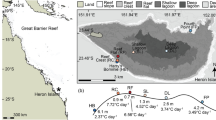Abstract
Adult Rangia cuneata (Gray) were spawned in the laboratory, and the combined effects of temperature and salinity on survival of fertilized eggs and on survival and growth of veliger larvae were studied. Embryos and larvae were reared at a number of temperature-salinity conditions within the ranges 8° to 32°C and 0 to 20‰ S. Salinities near 0‰ were lethal in all cases. Response surfaces were computed to analyze the combined effects on survival of embryos and on survival and growth of the larvae. Optimum conditions for embryos (85% survival) were 18° to 29°C and 6 to 10‰ S. Salinity had more effect than temperature on early development. Optimum conditions for the larvae were broader, being 8° to 32°C and 2 to 20‰ S. However, temperature and salinity interacted to reduce survival at low salinity-high temperature and high salinity-low temperature combinations. Growth of larvae was best at high salinities and high temperatures.
Similar content being viewed by others
Literature cited
Alderdice, D. F.: Some effects of simultaneous variation in salinity, temperature and dissolved oxygen on the resistance of young Coho salmon to a toxic substance. J. Fish. Res. Bd Can. 20, 525–550 (1963).
— and C. R. Forrester: Some effects of salinity and temperature on early development and survival of the English sole (Parophrys vetulus). J. Fish. Res. Bd Can. 25, 495–521 (1968).
Box, G. E. P.: The determination of optimum conditions. In: The design and analysis of industrial experiments, pp 495–551. Ed. by O. L. Davies. New York: Hafner 1956.
— and P. V. Youle: The exploration and exploitation of response surfaces: An example of the link between the fitted surface and the basic mechanism of the system. Biometrics 11, 287–323 (1955).
Calabrese, A.: Individual and combined effects of salinity and temperature on embryos and larvae of the Coot clam, Mulinia lateralis. Biol. Bull. mar. biol. Lab., Woods Hole 137, 417–428 (1969).
— and H. C. Davis: Tolerances and requirements of embryos and larvae of bivalve molluscs. Helgoländer wiss. Meeresunters. 20, 553–564 (1970).
Costlow, J. D., Jr., C. G. Bookhout and R. Monroe: The effect of salinity and temperature on larval development of Sesarma cinereum (Bosc) reared in the laboratory. Biol. Bull. mar. biol. Lab., Woods Hole 118, 183–202 (1960).
Davis, H. C.: Survival and growth of clam and oyster larvae at different salinities. Biol. Bull. mar. biol. Lab., Woods Hole 114, 296–307 (1958).
— and A. Calabrese: Combined effects of temperature and salinity on development of eggs and growth of larvae of M. mercenaria and C. virginica. Fishery Bull. Fish Wildl. Serv. U.S. 63, 643–655 (1964).
—: Survival and growth of larvae of the European oyster (Ostrea edulis L.) at different temperatures. Biol. Bull. mar. biol. Lab., Woods Hole 136, 193–199 (1969).
— and R. R. Guillard: Relative value of ten genera of microorganisms as foods for oyster and clam larvae. Fishery Bull. Fish Wildl. Serv. U.S. 58, 293–304 (1958).
Forrester, C. R. and D. F. Alderdice: Effects of salinity and temperature on embryonic development of the Pacific cod (Gadus macrocephalus). J. Fish. Res. Bd Can. 23, 319–340 (1966).
Haefner, P. A., Jr.: Temperature and salinity tolerance of the sand shrimp, Crangon septemspinosa Say. Physiol. Zoöl. 42, 388–397 (1969).
—: The effect of low dissolved oxygen concentrations on temperature-salinity tolerance of the sand shrimp, Crangon septemspinosa Say. Physiol. Zoöl. 43, 30–37 (1970).
Hopkins, S. H. and J. D. Andrews: Rangia cuneata on the east coast: thousand mile range extension or resurgence? Science, N.Y. 167, 868–869 (1970).
Kinne, O.: Physiological aspects of animal life in estuaries with special reference to salinity. Neth. J. Sea Res. 3, 222–244 (1966).
Smith, R. I.: On the early development of Nereis diversicolor in different salinities. J. Morphol. 114, 437–463 (1964).
Tenore, K. R., D. B. Horton and T. W. Duke: Effects of bottom substrate on the brackish water bivalve Rangia cuneata. Chesapeake Sci. 9, 238–248 (1968).
Ukeles, R.: The effect of temperature on the growth and survival of several marine algae species. Biol. Bull. mar. biol. Lab., Woods Hole 120, 255–264 (1961).
Ushakov, B. P.: Cellular resistance adaptation to temperature and thermostability of somatic cells with special reference to marine animals. Mar. Biol. 1, 153–160 (1968).
Wood, L. and W. J. Hargis: Transport of bivalve larvae in a tidal estuary. In: Fourth European Marine Biology Symposium, pp 29–44. Ed. by D. J. Crisp. New York: Cambridge Unviersity Press 1971.
Author information
Authors and Affiliations
Additional information
Communicated by J. Bunt, Miami
This paper is part of a dissertation submitted to the University of Virginia at Charlottesville, in partial fulfillment of the requirements for a Ph. D. degree. The work was accomplished at the laboratories of the Department of Marine Science at the Virginia Institute of Marine Science, Gloucester Point, Va. 23062 (USA). Support for research was funded by Virginia Electric and Power Company.
Virginia Institute of Marine Science Contribution No. 516.
Rights and permissions
About this article
Cite this article
Cain, T.D. The combined effects of temperature and salinity on embryos and larvae of the clam Rangia cuneata . Marine Biology 21, 1–6 (1973). https://doi.org/10.1007/BF00351185
Accepted:
Issue Date:
DOI: https://doi.org/10.1007/BF00351185




